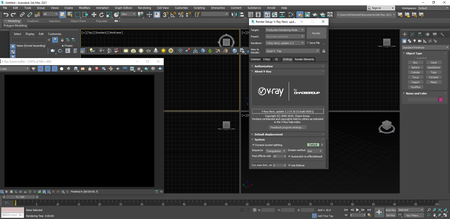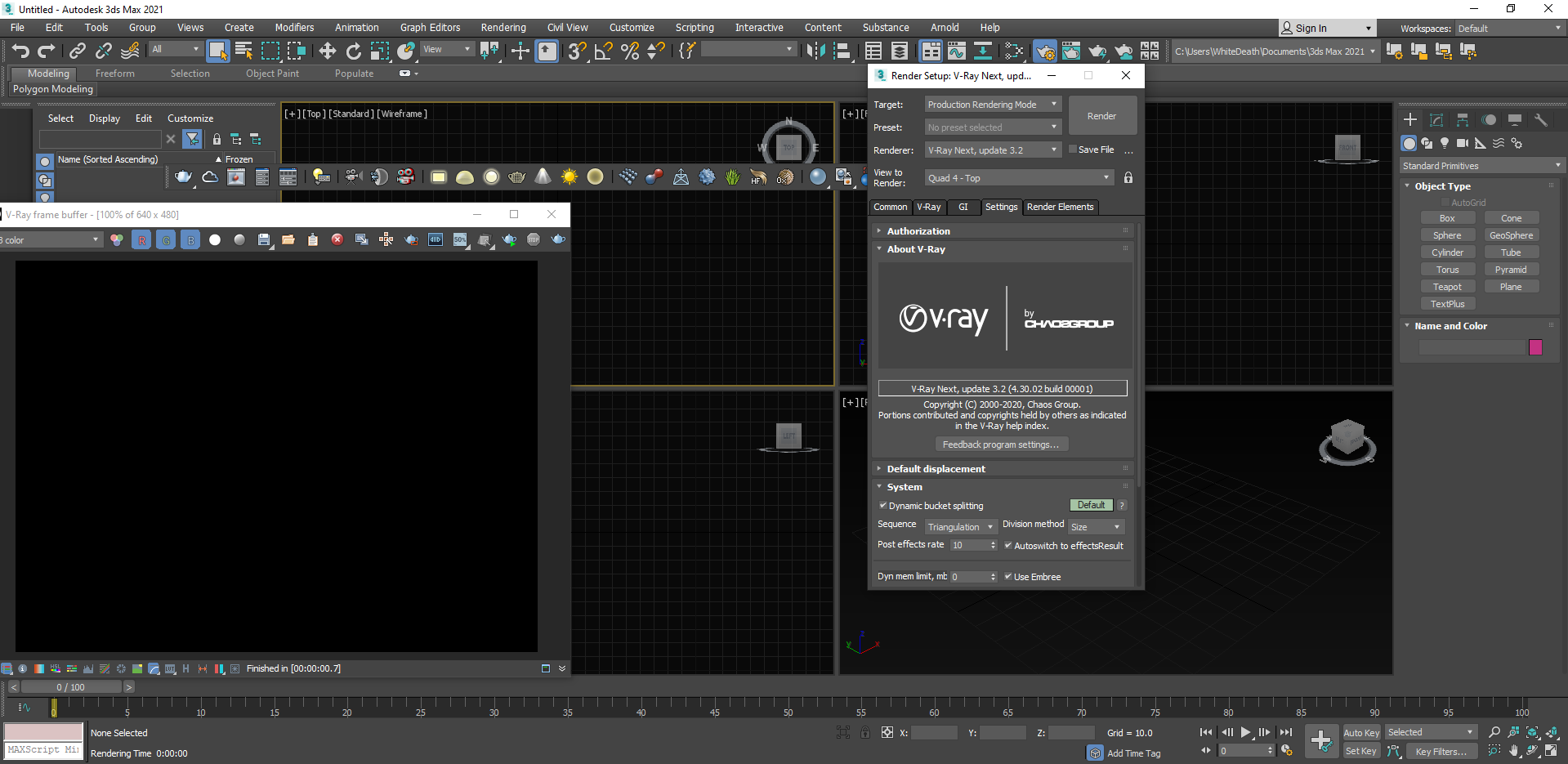Chaos Group V-Ray Next, Update 3.2 (build 4.30.02) for Autodesk 3ds Max | 2.1 Gb
The Chaos Group development team is pleased to announce the availability of V-Ray Next, Update 3.2 (Build 4.30.02) for Autodesk 3ds Max. As with all new versions, this release includes fixes to various user-reported issues from the previous release, providing an overall more stable experience.
New features:
- V-Ray: Support for 3ds Max 2021;
- V-Ray: Support for "Bake to Texture" in 3ds Max 2021;
Modified features:
- V-Ray: Improve performance scaling with 2nd gen Epyc dual 64-core setups 128 and more threads;
- V-Ray: Look for the XML file with the view graph for viewport IPR relative to the vrenderNNNN.dlr file location;
- VRayOSL: Add the ability to connect an OSL triple float output to a OSL single float input;
- VRayScene: Matte and Visibility control;
- VFB: Add MaxScript control for Test resolution through vfbcontrol;
- .vrscene exporter: Update SettingsPresenZ export;
Bug fixes:
- V-Ray: 3ds Max frame buffer has the same resolution as VFB regardless of the "Get resolution from Max option";
- V-Ray: Any click on the Light Cache preset dropdown changes the mode;
- V-Ray: Crash after baking to texture in 3ds Max 2021;
- V-Ray: EXR metadata in the VRayOptionRE is not saved with deep images;
- V-Ray: Fume FX render elements are missing in V-Ray renders;
- V-Ray: Random crash when rendering scene with VRayFur;
- V-Ray: Tiled EXR textures cause specific scene to render considerably slower compared to 4.1;
- V-Ray, V-Ray GPU: Incorrect internal reflection in glass when glossy Fresnel is enabled;
- V-Ray: VRayRenderID by node handle is not saved correctly in deep EXR output;
- V-Ray: Wrong 3ds Max Render output JPEG image with Test resolution;
- V-Ray IPR: Deleting/updating VRayInstancer or assigned materials won't cleanup material-clones-bindings and would lead to crash;
- V-Ray GPU/V-Ray Cloud: Anima AXYZ no animation when exported to vrscene;
- V-Ray GPU/V-Ray Cloud: BerconMapping doesn't render properly when exported to Standalone;
- V-Ray GPU: Bucket rendering produces black output when AA Filter size drops below 1.41;
- V-Ray GPU: Crash when rendering VRMesh files with more than 16 mapping channels;
- V-Ray GPU: Crash with VRayLightMtl with Direct illumination enabled, applied to tySpline;
- V-Ray GPU: Crash with VRayEnvironmentFog when switching from bucket to IPR between consecutive renderings;
- V-Ray GPU/V-Ray Cloud: Different result for BerconNoise in Standalone with some combinations of Noise Function and Fractal;
- V-Ray GPU: Rendering on GPU with NVLink spanning more than 2 cards results in a crash;
- V-Ray GPU/V-Ray Cloud: Tile UV mapping of the Bercon tile is not rendered properly;
- V-Ray GPU: VRayMtl is missing glossy reflections on the back side if "Reflect on back side" is enabled ;
- V-Ray GPU/V-Ray Cloud: VRayMtlID render element renders black;
- V-Ray Standalone: -skipExistingFrames breaks file output to current directory;
- V-Ray Standalone: -skipExistingFrames creates extra files in animation;
- VRayEnvironmentFog: Artifacts with custom geometry fog gizmo in a specific scene;
- VRayEnvironmentFog: Can not render with VRayNoiseTex used as density map;
- VRayEnvironmentFog: Renders significantly slower with Scatter GI in V-Ray Next;
- VRayFastSSS2: Material does not compose back to beauty properly;
- VRayFastSSS2: VRayLightSelect in full mode does not match beauty pass when diffuse amount is above 0;
- VRayGLSL: Float to int vector casts in shaders lead to crashes;
- VRayGLSL: Incorrect matrix multiplication results;
- VRayGLSL: Missing return statements in non-void GLSL functions lead to crashes;
- VRayMtl: 100% white Opacity Map affects material Reflections;
- VRayOSL: Crash in material editor preview rendering after editing OSL texture from MaxScript;
- VRayOSL: Crash with Bitmap texture vrayattached to VRayOSLTex while exporting for V-Ray GPU;
- VRayScene: Compiling geometry time is increasing with each frame in animation rendering with V-Ray Standalone;
- VRayVolumeGrid: Volumetric rendering slow-down with Volume Light Cache enabled with V-Ray memtracker;
- V-Ray: Support for 3ds Max 2021;
- V-Ray: Support for "Bake to Texture" in 3ds Max 2021;
Modified features:
- V-Ray: Improve performance scaling with 2nd gen Epyc dual 64-core setups 128 and more threads;
- V-Ray: Look for the XML file with the view graph for viewport IPR relative to the vrenderNNNN.dlr file location;
- VRayOSL: Add the ability to connect an OSL triple float output to a OSL single float input;
- VRayScene: Matte and Visibility control;
- VFB: Add MaxScript control for Test resolution through vfbcontrol;
- .vrscene exporter: Update SettingsPresenZ export;
Bug fixes:
- V-Ray: 3ds Max frame buffer has the same resolution as VFB regardless of the "Get resolution from Max option";
- V-Ray: Any click on the Light Cache preset dropdown changes the mode;
- V-Ray: Crash after baking to texture in 3ds Max 2021;
- V-Ray: EXR metadata in the VRayOptionRE is not saved with deep images;
- V-Ray: Fume FX render elements are missing in V-Ray renders;
- V-Ray: Random crash when rendering scene with VRayFur;
- V-Ray: Tiled EXR textures cause specific scene to render considerably slower compared to 4.1;
- V-Ray, V-Ray GPU: Incorrect internal reflection in glass when glossy Fresnel is enabled;
- V-Ray: VRayRenderID by node handle is not saved correctly in deep EXR output;
- V-Ray: Wrong 3ds Max Render output JPEG image with Test resolution;
- V-Ray IPR: Deleting/updating VRayInstancer or assigned materials won't cleanup material-clones-bindings and would lead to crash;
- V-Ray GPU/V-Ray Cloud: Anima AXYZ no animation when exported to vrscene;
- V-Ray GPU/V-Ray Cloud: BerconMapping doesn't render properly when exported to Standalone;
- V-Ray GPU: Bucket rendering produces black output when AA Filter size drops below 1.41;
- V-Ray GPU: Crash when rendering VRMesh files with more than 16 mapping channels;
- V-Ray GPU: Crash with VRayLightMtl with Direct illumination enabled, applied to tySpline;
- V-Ray GPU: Crash with VRayEnvironmentFog when switching from bucket to IPR between consecutive renderings;
- V-Ray GPU/V-Ray Cloud: Different result for BerconNoise in Standalone with some combinations of Noise Function and Fractal;
- V-Ray GPU: Rendering on GPU with NVLink spanning more than 2 cards results in a crash;
- V-Ray GPU/V-Ray Cloud: Tile UV mapping of the Bercon tile is not rendered properly;
- V-Ray GPU: VRayMtl is missing glossy reflections on the back side if "Reflect on back side" is enabled ;
- V-Ray GPU/V-Ray Cloud: VRayMtlID render element renders black;
- V-Ray Standalone: -skipExistingFrames breaks file output to current directory;
- V-Ray Standalone: -skipExistingFrames creates extra files in animation;
- VRayEnvironmentFog: Artifacts with custom geometry fog gizmo in a specific scene;
- VRayEnvironmentFog: Can not render with VRayNoiseTex used as density map;
- VRayEnvironmentFog: Renders significantly slower with Scatter GI in V-Ray Next;
- VRayFastSSS2: Material does not compose back to beauty properly;
- VRayFastSSS2: VRayLightSelect in full mode does not match beauty pass when diffuse amount is above 0;
- VRayGLSL: Float to int vector casts in shaders lead to crashes;
- VRayGLSL: Incorrect matrix multiplication results;
- VRayGLSL: Missing return statements in non-void GLSL functions lead to crashes;
- VRayMtl: 100% white Opacity Map affects material Reflections;
- VRayOSL: Crash in material editor preview rendering after editing OSL texture from MaxScript;
- VRayOSL: Crash with Bitmap texture vrayattached to VRayOSLTex while exporting for V-Ray GPU;
- VRayScene: Compiling geometry time is increasing with each frame in animation rendering with V-Ray Standalone;
- VRayVolumeGrid: Volumetric rendering slow-down with Volume Light Cache enabled with V-Ray memtracker;
V-Ray Next for 3ds Max Update 3, the next update to the 3ds Max edition of the production renderer, adding support for hardware-accelerated ray tracing on Nvidia RTX graphics cards. Rendering now ‘about 40%’ faster when rendering on Nvidia RTX GPUs
There’s only one major new feature in Update 3, although it’s one that we suspect will be of interest to a lot of V-Ray for 3ds Max users: RTX acceleration.
V-Ray Next can now make use of the dedicated RT ray tracing cores in Nvidia’s GeForce RTX, Titan RTX and Quadro RTX GPUs to speed up renders. The new RTX engine is implemented as an alternative to the existing CUDA engine, and can be selected manually when rendering on an RTX card. The average performance increase is “about 40%”.
In addition, V-Ray Next for 3ds Max Update 3 adds support for deep EXR output when rendering with V-Ray GPU, plus a number of smaller feature improvements.
V-Ray NEXT for 3ds Max: The Next Generation of Rendering
Chaos Group is a worldwide leader in computer graphics technology, helping artists and designers create photoreal imagery and animation for design, television, and feature films. Chaos Group specializes in physically-based rendering and simulation software used daily by top design studios, architectural firms, advertising agencies, and visual effects companies around the globe. Today, the company's research and development in cloud rendering, material scanning, and virtual reality is shaping the future of creative storytelling and digital design. Founded in 1997, Chaos Group is privately owned with offices in Sofia, Los Angeles, Baltimore, Seoul, and Tokyo.
Product: Chaos Group V-Ray
Version: Next Update 3.2 (Build 4.30.02)
Supported Architectures: x64
Website Home Page : www.chaosgroup.com
Language: english
System Requirements: PC *
Supported Operating Systems: *
Software Prerequisites: *
Size: 2.1 Gb
The requirements listed here are for the latest version of V-Ray in 3ds Max. Please make sure that your system meets the requirements listed below before installing V-Ray.
Processor 1st Gen Intel Core or compatible processor with SSE4.2 support (x64)
RAM 4 GB RAM and 4 GB swap minimum – recommended 8 GB or more RAM, 8 GB or more swap file
Operating system Microsoft Windows 7 (SP1), Windows 8.1, or Windows 10 Professional operating system
Autodesk 3ds Max 3ds Max 2016, 2017, 2018, 2019, 2020 and 2021 (64-bit)
USB port Required for hardware lock, preferably USB 2.0
TCP/IP Only IPv4 is supported. IPv6 is currently not supported.
License Server 4.5.1 or later
GPU Support Maxwell-, Pascal-, Volta- and Turing-based NVIDIA card(s) with latest video driver or at least version 411.31
Processor 1st Gen Intel Core or compatible processor with SSE4.2 support (x64)
RAM 4 GB RAM and 4 GB swap minimum – recommended 8 GB or more RAM, 8 GB or more swap file
Operating system Microsoft Windows 7 (SP1), Windows 8.1, or Windows 10 Professional operating system
Autodesk 3ds Max 3ds Max 2016, 2017, 2018, 2019, 2020 and 2021 (64-bit)
USB port Required for hardware lock, preferably USB 2.0
TCP/IP Only IPv4 is supported. IPv6 is currently not supported.
License Server 4.5.1 or later
GPU Support Maxwell-, Pascal-, Volta- and Turing-based NVIDIA card(s) with latest video driver or at least version 411.31
Please visit my blog
Added by 3% of the overall size of the archive of information for the restoration
No mirrors please
Added by 3% of the overall size of the archive of information for the restoration
No mirrors please







